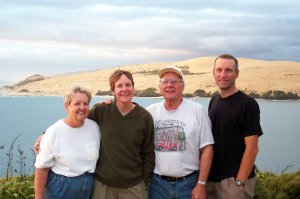| Greetings from New Zealand! In mid-January
we arrived in Auckland, the largest city in New
Zealand with about 1 million of NZ's 3.8 million
people. The rest of the country is thankfully
uncrowded, helping to make New Zealand one of the top
outdoor holiday vacation destinations in the world.
Since we're now in the southern hemisphere, we are
enjoying the warm weather of summer, with most days
high around 25C (77F), with only a few days of rain.
The North Island, where we have spent the last
month, has more people than the South Island, and the
terrain has more thermal features (e.g., volcanoes,
hot springs) than the South Island. We had previously
taken two trips to New Zealand, but had spent only a
few days in the North. We have been pleasantly
surprised to find the beauty of the North Island
beyond our original expectations - the South Island
is generally considered the more spectacular of the
two.
We started by cycling east to the Coromandel
Peninsula, where we met Shelley's parents, Ray and
Sue, who flew out from the USA to travel with us for
a couple of weeks.
We spent about 10 days cycling around the
peninsula, including one day of tough off-road
touring on singletrack across the northern point of
the peninsula from Fletcher Bay to Stony Bay. A
friend of ours once said that he never met a hill he
couldn't walk. We may have one for him on this trip!
Carrying all our gear in the BOB trailers, the bikes
were so hard to push up one hill that we had to stop,
set our feet on the gravel and dirt, bench-press the
bike one arm's length forward, hold the brakes on the
bike (to keep it from rolling downhill), and then
take two tentative steps forward while holding the
bike in place. The views, however, were worth it!
After exploring much of the Coromandel Peninsula,
we stuffed all our gear in the back of Ray and Sue's
rental car. A Toyota Camry can hold an amazing amount
of stuff when adequately persuaded! We drove back
through the traffic of Auckland and to the
Northlands, skipping back and forth between the Bay
of Islands on the east coast, the Kauri Coast on the
west, and the northern point of New Zealand at Cape
Reinga.
In the 19th century, New Zealand's forests of the
giant Kauri trees were virtually destroyed for their
fine timber. The sap (gum) from these trees was
collected for use in varnishes, spawning an industry
of "gumdiggers" who (as the name suggests)
dug for deposits of gum from ancient trees. The
remaining trees are magnificent - the largest, named "Tane
Mahuta", or "God of the Forest",
is 2000 years old, 51 meters in height, with a trunk
girth of nearly 14 meters. That's about 4.5 meters in
diameter - over 14 feet across. The trees are now
protected, and are only felled at special times for
the building of Maori canoes. We were able to see
many of these trees along the so-called "Kauri
Coast" northwest of Auckland.
The northern tip of New Zealand becomes
increasingly remote. At the tip of the Aupouri
Peninsula sits Cape Reinga, where the solar-powered
lighthouse sits on a wind-swept point overlooking the
meeting of the Pacific Ocean and the Tasman Sea.
Sue and Ray returned to the USA after two weeks,
and we continued to cycle down the east coast north
of Auckland, finishing the month of January spending
several days at nearly deserted campsites on the
beautiful sandy beaches, coves, and bays around the
Kerikeri peninsula and the Bay of Islands. One day we
rode only 10km (6 miles!) between campsites. What
kind of hurry should we be in?
|

Shelley pulls a BOB trailer
on the Coromandel Penninsula

Sunset at Fletcher Bay

MOO!
Sharing the trail to Stony Bay

On the trail to Stony Bay

Shelley negotiates some remote singletrack

Secluded campsite at Stony Bay

Shelley rides a Flying Fox

Flowers at Opito Bay

With the Bitels at Omapere

Lighthouse at Cape Reinga
|